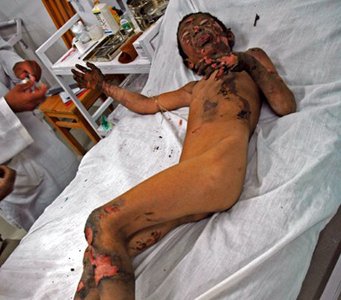More than 1,000 civilians were killed in Afghanistan in 2006, most of them as a result of attacks by the Taliban and other anti-government forces in the country's unstable south, a rights group said Tuesday.

Photos from NATO bomb victims by Maso Notarianni at the Emergency Hospital in Lashkar Gah
more photos and details | Photos Index
Human Rights Watch said that at least 100 of those civilian deaths were caused by NATO and U.S.-led troop operations, far below another estimate by an Afghan rights group.
In all, more than 4,400 Afghans — comprising civilians and combatants — died in conflict-related violence, twice as many as in 2005 and more than in any other year since the United States helped oust the Taliban in 2001, the New-York-based group said in a statement.
An Associated Press tally based on reports from Afghan, NATO and coalition officials puts the overall death toll slightly lower, at about 4,000, most of them militants.
Taliban-led guerrillas launched a record number of attacks last year and engaged in several pitched battles with foreign troops, who now number more than 40,000, the most since the fall of the fundamentalist militia.
With warlords and drug traffickers still powerful, the organization said Afghan President Hamid Karzai and donor nations had failed to meet promises to improve governance, the economy and security under plans to be reviewed at an international meeting on Afghanistan starting Tuesday in Berlin.
"Afghanistan hasn't really met any of the benchmarks" on improving human rights or security, said Sam Zafiri, Asia research director of Human Rights Watch. "Life is so dangerous that many Afghans don't feel safe enough to go to school, get health care, or take goods to market."
Human Rights Watch did not explain the methodology it used to arrive at its casualty numbers.
Its figure of 100 civilians killed by foreign troops is far fewer than the 600 tallied by Afghanistan's Independent Human Rights Commission. The commission also has not explained how it arrived at its figure, and has released no overall estimate of civilian casualties.
Civilians have often been caught in the middle of Afghanistan's recent wars, starting when Soviet troops invaded in 1979. Statements about the numbers of people killed and wounded in the current conflict sometimes differ widely, depending on who provides the information.
For instance, an airstrike in October 2006 in southern Afghanistan's volatile Panjwayi district killed between 30 and 80 civilians, according to accounts provided by the Afghan government and villagers. Yet NATO identified only 12 civilian deaths.
Karzai and the United Nations have repeatedly called on all sides to do more to avoid civilian casualties.
Human Rights Watch urged NATO nations to provide compensation for civilian casualties and damage to property caused by its operations.
It also called on donors such as the United States and European nations to provide more political, economic and military assistance and said that Karzai needs to take action against abusive warlords, some of them allied his government.
The U.S. government said last week it plans to provide another US$10.6 billion (€8.2 billion) for Afghanistan, much of it for Afghan security forces. The EU's executive office has proposed a new €600 million (US$780 million) aid package.



